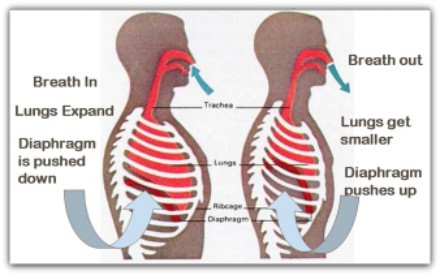When I first started singing, breath management wasn’t even a consideration (I used to smoke a pack a day when I was younger for goodness sake!) & really paid no attention to the anatomy or technique involved in singing.
Natural ability & self-study through practice can lay a foundation for your voice but over time, a growing gig workload & getting older plus any bad habits & anything you aren’t doing as well as you can, it really shows up when you least want or expect it!
After freeing myself from the chains of smoking & studying vocal technique I’ve learnt of a couple keys things that I hope help you too.
Here are the quick fast facts – read on below these for more in-depth info.
The steps to achieve effective breathing:
1. Use a mirror to check/assess your technique
2. Align your posture to a neutral position
3. Inhale expanding 360 degrees around your waistline
4. Exhale trying to keep your ribs open
5. Slowly return your ribs/abdominals to their starting position
A great place to start is with a check on what you are currently doing. Are you having problems with pitch, creating the tone you want or a lack of power? Learning to manage your breath can help with these things.
Next up, check your postural alignment – have you got a comfortably elevated chest? Are you holding any tension in your shoulders neck & throat? Is your pelvis in a neutral position? Relaxed knees & feet shoulder-width apart?
Now watch yourself in a mirror (or video yourself) & check to see that your shoulders aren’t rising up. You can place a pincer grip of your thumb & forefinger on your waist to see if you are expanding 360 degrees through your waistline (relax your abs – try to not worry about holding your stomach in for aesthetic reasons!!)
You can practice controlling this action with breathing exercises i.e: exhaling on an “sss” sound, like a hiss & timing how long you can go for aiming over time to develop the control of your exhale so that you can sustain that hiss for longer, training your intercostal muscles (the muscles in between your ribs that cause them to contract & release) to stop the release or collapse of your rib cage & forcing air out.
You can also challenge your inward breath by taking small sips of air for ten counts versus one ‘full’ breath.
Some handy things to note:
- You don’t need to take a BIG breath & FILL up your lungs when taking a breath for singing. If anything, try letting half your air out before you start to sing a note. That build-up of pressure can add tension to your vocal folds (True & False vocal folds – didn’t know you have two sets? More on that in another post then!)
- The organs that are involved in breathing specifically are the lungs, not the diaphragm! The diaphragm is a dome-shaped involuntary muscle & you can’t ‘control’ it’s movement directly & its function is automatic which is great for breathing whilst sleeping – cos you’d have some issues reminding it to trigger the breathing process whilst you were out for the count! The bottom line is you can’t actually sing FROM your diaphragm, but rather the diaphragm begins the breathing process by pulling down on the lungs to create a vacuum so air can rush in (the inhale).
- The trick is to control as best you can the exhale. Creating a steady stream of air pressure under the vocal folds will help you to produce a consistent balanced tone, pitch amongst other things like power & resonance once you coordinate the entire singing processes. You do this by engaging fully with the infrastructure that the diaphragm is connected to, the ribs & spine. You aim to control the return of your rib cage to it’s starting position. When your ribs collapse too fast they cause the diaphragm to move upwards quickly & in turn that pushes the air out of the lungs. Ideally, you slow this process down by controlling the slow release of your ribs & abdominals to their starting position ready to inhale again.
So that’s breathing in a nutshell! It’s a lot to think about & we haven’t even started making sounds yet!
It’s good to have an understanding of the inner workings as the breath is the generator for singing & powers your voice – important stuff!
Any questions about breath management or singing in general, holler! I’m always hovering in the Facebook group as well or you can leave a comment below!
Here’s to some crackalackin’ breath management for signing!


